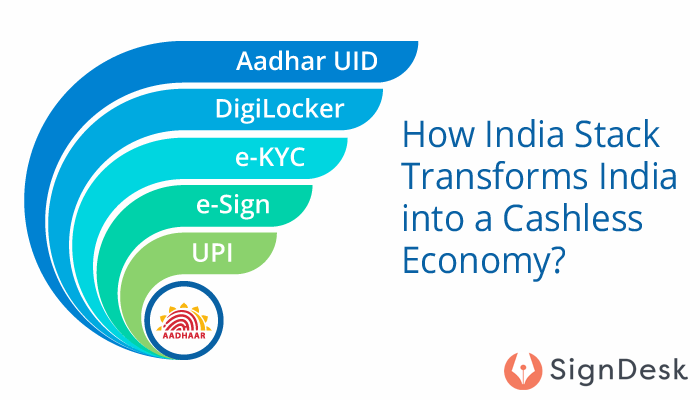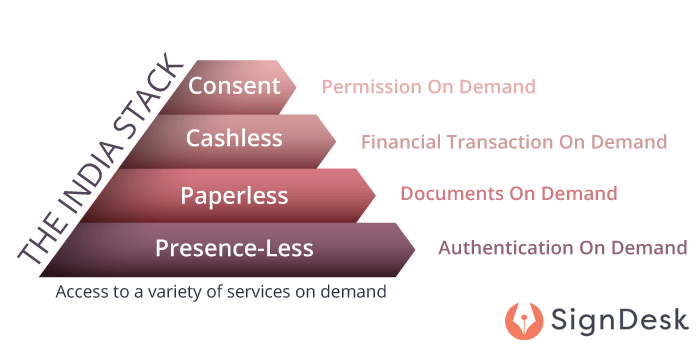Aadhaar had crossed the one billion mark in September 2015 and become the world’s largest biometric identity project. iSPIRIT (Indian Software Product Industry Round Table) is a volunteer organisation and is the driving force behind India Stack. India Stack is a set of APIs which allows the government and private companies to deploy cashless and paperless technology products. These APIs are maintained independently by their owners but the India Stack drives adoption by developers through their events.

This demographic biometric information collected by UIDAI has created several opportunities through the addition of the open technology platform. The government has created this digital platform of the freeway system through APIs that sit atop the biometric-enabled Aadhaar system.
Looking into this, one would wonder why the Aadhaar garners a lot of interest. Here are three reasons why:
- The successful completion of the largest biometric identity project in the world
- There are over 200+ startups in the Fintech and the payments space
- UPI framework enables APIs for payments in India
4 Major Layers of India Stack
Aadhaar or the biometric identity is the bottom-most layer in this value-added stack offering. Using the Aadhaar identity, the paperless layer uses the e-KYC and e-documentation services. Currently, 16.96 billion e-KYCs have been initiated by consumers and this has helped the government save more than $7 billion till date.

The four major layers of India Stack include the Consent Layer, Cashless Layer, Paperless Layer and Presence-less Layer. This can be explained in a nutshell as follows:
- Consent Layer: This layer is a modern privacy data-sharing framework with an open personal data store and is owned by the Reserve Bank of India.
- Cashless Layer: This is an electronic interoperable payment network and includes IMPS, AEPS, APB and UPI and is owned by the National Payments Corporation of India (NPCI).
- Paperless Layer: This can easily store and retrieve information digitally. It includes Aadhaar e-KYC, e-Sign, and the Digital Locker. This paperless layer is owned by the Department of Electronics and Information Technology
- Presence-less Layer: This is a unique digital biometric identity with open API access. This layer includes the Aadhaar card and Mobile Aadhaar and is owned by the Unique Identification Authority of India.
Key Parts of India Stack
Now we will list out the key parts that consist of India Stack and it will play a larger role in our day to day lives.
Unique Identification Number
The India Stack or Aadhaar Stack is made up of the UIDAI. This is the Unique Identification Number which is linked to the biometric readings of the individual.
e-KYC
In order to receive industry feedback, Aadhaar was added as an e-KYC project. This enables organizations to get instant verification of customers. Some of the details that are provided include the place of residence and the date of birth of the individual.
AEPS
The NPCI developed the Aadhaar Enabled Payments Systems or AEPS. Using AEPS, this improves financial inclusion for retail outlets that can go cashless and allows for disbursement of government entitlements and bank to bank transfers.
UPI
The Unified Payment Interface or UPI enables a payment request and customer to send funds to a beneficiary and collect requests from a customer for payment. The best part is that it allows India to trade and transact digitally.
eSign
eSign is enabled through an API that facilitates an Aadhaar cardholder to electronically sign documents. This is authenticated through biometric readings and through an OTP. This reduces paperwork with the authentication process and provides legal validity with this signing mechanism. All eSigns are managed by the Controller of Certifying Authorities which is a part of the Ministry of Electronics and Information Technology.
DigiLocker
Another great feature is a DigiLocker that is used as a Government of India repository for documents. Also, users can sign up for services by linking their Aadhaar cards and similarly it can be used to upload documents, eSign these documents and share the documents at any time, from anywhere.
The second component, apart from the DigiLocker of the Paperless Layer, is the Digital Signature. This provides the capability that allows individuals to electronically sign contracts with any entity without a pen or paper.
The Way Forward
India Stacks presents the opportunity for private players to enable disruption. This is done by taking down the cost of customer acquisition and ongoing maintenance. This enables businesses to tap into the customer segment which is currently out of reach.
This would enable even the street vendor that does not have a bank account to make all their transactions digital and uses this information to grow their businesses and invest in savings. In the long run, India Stack will build a digital portal to the entire financial world.